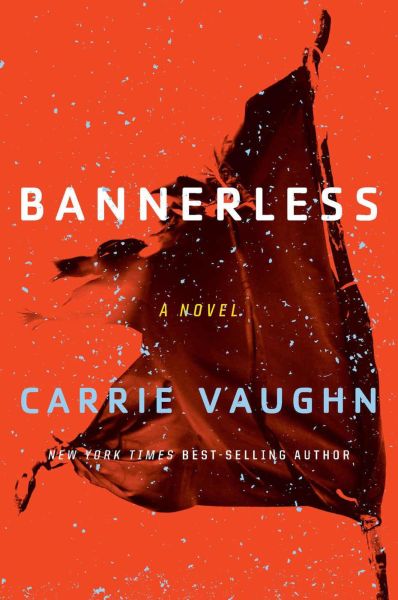Why Does The Sun Go On Shining
Bannerless (Bannerless Saga, volume 1)
By Carrie Vaughn

22 Jun, 2018
2017’s Bannerless is the first volume of Carrie Vaughn’s Bannerless Saga.
Plague and natural disasters brought down civilization as we know it. Where once there were vast cities, the Fall left only small hamlets trying to preserve what technology they can. Humans being the social animals they are, they still form communities, still have customs and laws to guide them.
Humans being humans, customs and laws require enforcement. For this, the Coast Road communities rely on investigators like Enid and Tomas. From banner violations — illicit childbirth — to murder, from hoarding to domestic violence, it is up to the investigators to determine if a crime has been committed and deliver judgment.
Sometimes, as in the Pasadan case, whether or not a crime was committed is not at all clear.
Sero is very definitely dead. That’s clear. So is the immediate cause of death, a violent blow to the head. What is not clear is whether the blow was a workshop accident or delivered by another human. If it was the work of another human, the blow could have been an accident … or murder. Since nobody admits to having seen the event that killed Sero, Enid must rely on physical evidence and what she can learn by repeatedly questioning the people of Pasadan.
What her interrogations tell Enid: Sero was a loner, widely believed (falsely) to have been born bannerless. Sero’s reluctance to socialize may have been due to his speech impediment, but Pasadans treated him as a pariah because they believed him an illicit birth. Sero’s skills and tools made him an asset to the community, but not someone that the other Pasadans would invite to dinner.
What the evidence tells Enid: someone left a bloody handprint near the workshop where Sero died. Someone witnessed whatever happened. The fact that the witness did not come forward says whatever happened to Sero was probably not a simple accident. It is up to Erin to uncover Pasadan’s secrets.
~oOo~
Today’s review was intended to cover Kitty’s House of Horrors (Kitty Norville, book 7). It turns out that before one can review a book, one must have read it. I thought I owned a copy; I was wrong. House of Horrors will have to wait until July. But I am not disappointed; having to read something, I finally read my e‑copy of Bannerless … and liked it a lot.
This is a cozy post-apocalyptic novel, in which the megadeaths [1] happened sufficiently long ago that there are few surviving witnesses to the horror. By Enid’s time, the catastrophe has become the stuff of second-hand stories fading into legend. The surviving Coast Road communities are pleasant places to live, which suggests that humans are occasionally capable of learning from bad experiences. Would that this were more often true.
Most of North America has not adapted as well as have the folks of Coast Road. Conditions elsewhere can be horrific. Even the Coast Road lives on a knife-edge. Agriculture and industry are artisanal, not mechanized. Crop yields are low, which means low surpluses and less stored food than desirable. Climate-driven weather changes occasionally kill crops; famine is always a possibility.
There’s none of the sophisticated medical care of the past; one can die at age forty from what would formerly have been a treatable heart condition. At least the Coast Road knows about handwashing, so death in childbirth must be less common than it would have been, say, in the early 1800s.
This is a mystery, featuring one investigator and her companion, and one case. It’s not an anthropological study. I wanted to know more about the setting, but was given only vague hints. Towns seem to be run by committees. How are the members selected? Dunno. There appears to be a central government of some kind, one that regulates population and promotes sustainable agriculture. How is that government selected? How do they enforce their rules? We meet investigators, but no police force.
All that said, it was nice to read about a world in which the Fall did not lead to wandering armies of cannibals, the reinstatement of feudalism, and the reduction of women to the status of farm animals. Coast Road’s government might seem a heavy-handed nanny state when it comes to crop rotation and having kids, but they’ve managed to cobble together a functioning society that is far from horrible.
Considered just as a mystery, the novel succeeds. The author drops clues, not all of which are red herrings. Every community has its dark little secrets and Pasadan is no exception. Unraveling all those secrets complicates Enid’s job pleasingly. Well, not to her, but for the reader. I would definitely watch a BBC or even a Netflix adaptation of this series.
Bannerless is available here (Amazon) and here (Chapters-Indigo).
1: The upside of having 7.6 billion people in the world is that even if something kills ninety-nine out of a hundred humans, that still leaves 76 million survivors. That’s fewer humans than the Earth has supported since … the Bronze Age, I’m guessing. But it’s still more people than currently live in Canada. Humans will not go extinct.
